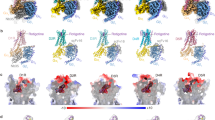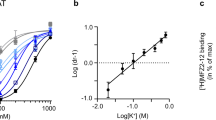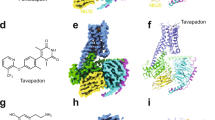Abstract
THE importance of the dopaminergic system in brain function has been emphasized by its association with neurological and psychiatric disorders such as Parkinson's disease and schizophrenia. On the basis of their biochemical and pharmacological characteristics, dopamine receptors are classified into D1 and D2 subtypes1,2. As the most abundant dopamine receptor in the central nervous system, D1 receptors seem to mediate some behavioural responses3, modulate activity of D2 dopamine receptors4,5, and regulate neuron growth and differentiation6. The D2 dopamine receptor has been cloned by low-stringency screening7. We report here the cloning of human and rat D1 dopamine receptors by applying an approach based on the polymerase chain reaction8. The cloned human D1 dopamine receptor has been characterized on the basis of four criteria: the deduced amino-acid sequence, which reveals that it is a G protein-coupled receptor; the tissue distribution of its messenger RNA, which is compatible with that of the Dl dopamine receptor; its pharmacological profile when transfected into COS-7 cells; and its ability to stimulate the accumulation of cyclic AMP in human 293 cells.
This is a preview of subscription content, access via your institution
Access options
Subscribe to this journal
Receive 51 print issues and online access
$199.00 per year
only $3.90 per issue
Buy this article
- Purchase on Springer Link
- Instant access to full article PDF
Prices may be subject to local taxes which are calculated during checkout
Similar content being viewed by others
References
Kebabian, J. W. & Calne, D. B. Nature 277, 93–96 (1979).
Creese, I., Sibley, D. R., Hamblin, M. W. & Leff, S. E. A. Rev. Neurosci. 6, 43–71 (1983).
Clark, D. & White, F. J. Synapse 1, P347–P388 (1987).
Walters, J. R., Bergstrom, D. A., Carlson, J. H., Chase, T. N. & Braun, A. R. Science 236, 719–722 (1987).
Waddington, J. L. J. Psychopharmacol. 3, 54–63 (1989).
Lankford, K. L., DeMello, F. G. & Klein, W. L. Proc. natn. Acad. Sci. U.S.A. 85, 4567–4571 (1988).
Bunzow, J. R. et al. Nature 336, 783–787 (1988).
Saiki, R. K. et al. Science 239, 487–491 (1988).
Dohlman, H. G., Caron, M. G. & Lefkowitz, R. J. Biochemistry 26, 2657–2664 (1987).
Libert, F. et al. Science 244, 569–572 (1989).
Boyson, S. J., McGonigle, P. & Molinoff, P. B. J. Neurosci. 6, 3177–3188 (1986).
O'Dowd, B. F. et al. J. biol. Chem. 263, 15985–15992 (1988).
Emorine, L. J. et al. Science 245, 1118–1121 (1989).
Regan, J. W. et al. Proc. natn. Acad. Sci. U.S.A. 85, 6301–6305 (1988).
Strader, C. D., Candelore, M. R., Hill, W. S., Sigal, I. S. & Dixon, R. A. F. J. biol. Chem. 264, 13572–13578 (1989).
Lefkowitz, R. J. et al. Cold Spring Harb. Symp. quant. Biol. 53, 507–514 (1988).
Jarvie, K. R., Booth, G., Brown, E. M. & Niznik, H. B. Molec. Pharmacol. 36, 566–574 (1989).
Grandy, D. K. et al. Proc. natn Acad. Sci. U.S.A. 86, 9762–9766 (1989).
Kobilka, B. K. et al. Proc. natn Acad. Sci. U.S.A. 84, 46–50 (1987).
Frielle, T. et al. Proc. natn. Acad. Sci. U.S.A. 84, 7920–7924 (1987).
Cotecchia, S. et al. Proc. natn. Acad. Sci. U.S.A. 85, 7159–7163 (1988).
Kobilka, B. K. et al. Science 238, 650–656 (1987).
Strader, C. D. et al. J. biol. Chem. 263, 10267–10271 (1988).
Venter, J. C., Fraser, C. M., Kerlavage, A. R. & Buck, M. Biochem. Pharmacol. 38, 1197–1208 (1989).
Kishimoto, A. et al. J. biol. Chem. 260, 12492–12499 (1985).
Bouvier, M. et al. Nature 333, 370–374 (1988).
Cullen, B. R. Meth. Enzym. 152, 684–704 (1987).
Niznik, H. B. et al. Molec. Pharmacol. 34, 29–36 (1990).
Chen, C. & Okayama, H. Molec. cell. Biol. 7, 2745–2752 (1987).
Brown, B. L., Albano, J. D., Ekins, R. P. & Sgherzi, A. M. Biochem. J. 171, 561–562 (1971).
Author information
Authors and Affiliations
Rights and permissions
About this article
Cite this article
Zhou, QY., Grandy, D., Thambi, L. et al. Cloning and expression of human and rat Dt dopamine receptors . Nature 347, 76–80 (1990). https://doi.org/10.1038/347076a0
Received:
Accepted:
Issue Date:
DOI: https://doi.org/10.1038/347076a0
This article is cited by
-
Initial characterization of a transgenic mouse with overexpression of the human D1-dopamine receptor in the heart
Naunyn-Schmiedeberg's Archives of Pharmacology (2024)
-
OZITX, a pertussis toxin-like protein for occluding inhibitory G protein signalling including Gαz
Communications Biology (2022)
-
Rationale in support of the use of selective dopamine D3 receptor antagonists for the pharmacotherapeutic management of substance use disorders
Naunyn-Schmiedeberg's Archives of Pharmacology (2013)
-
Further Characterization of a Novel Tetrapeptide with an Analgesic Action in the Central and Peripheral Nervous System in Rats
International Journal of Peptide Research and Therapeutics (2012)
Comments
By submitting a comment you agree to abide by our Terms and Community Guidelines. If you find something abusive or that does not comply with our terms or guidelines please flag it as inappropriate.



